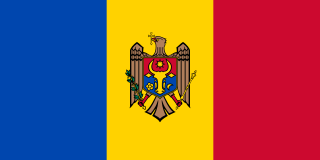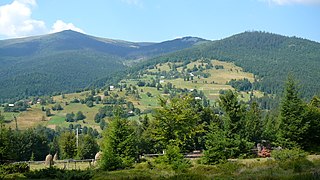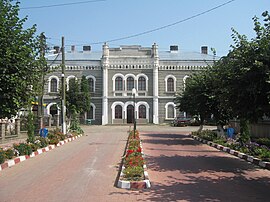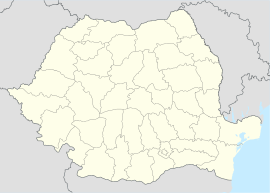
Moldova, officially the Republic of Moldova is a sovereign state in Eastern Europe. It is bordered by Romania to the west and Ukraine to the north, east, and south with which a deal was struck in 2005 for access to the Black Sea, ending Moldova's landlocked status. The unrecognised, breakaway region of Transnistria lies across the Dniester on the country's eastern border with Ukraine. The capital and largest city is Chișinău.

Romania is a country located at the crossroads of Central, Eastern and Southeastern Europe. It borders Bulgaria to the south, Ukraine to the north, Hungary to the west, Serbia to the southwest, Moldova to the east and the Black Sea to the southeast. It has a predominantly temperate-continental climate, and an area of 238,397 km2 (92,046 sq mi), with a population of around 19 million. Romania is the twelfth-largest country in Europe, and the sixth-most populous member state of the European Union. Its capital and largest city is Bucharest, and other major urban areas include Iași, Cluj-Napoca, Timișoara, Constanța, Craiova, Brașov, and Galați.

Romanian is a Balkan Romance language spoken by approximately 22–26 million people as a native language, primarily in Romania and Moldova, and by another 4 million people as a second language. According to another estimate, there are about 34 million people worldwide who can speak Romanian, of whom 30 million speak it as a native language. It is an official and national language of both Romania and Moldova and is one of the official languages of the European Union.
This article covers the history and bibliography of Romania and links to specialized articles.

Transylvania is a historical region in central Romania. To the east and south its natural border is the Carpathian Mountains, and to the west the Apuseni Mountains. Broader definitions of Transylvania also encompass the western and north-western Romanian regions Crișana and Maramureș, and occasionally Banat.

The Warsaw Treaty Organization (WTO), officially the Treaty of Friendship, Cooperation and Mutual Assistance, commonly known as the Warsaw Pact (WP), was a collective defense treaty signed in Warsaw, Poland, between the Soviet Union and seven other Eastern Bloc socialist republics of Central and Eastern Europe in May 1955, during the Cold War. The Warsaw Pact was the military complement to the Council for Mutual Economic Assistance (CoMEcon), the regional economic organization for the socialist states of Central and Eastern Europe. The Warsaw Pact was created in reaction to the integration of West Germany into NATO in 1955 as per the London and Paris Conferences of 1954.

Bucharest is the capital and largest city of Romania, as well as its cultural, industrial, and financial centre. It is located in the southeast of the country, on the banks of the Dâmbovița River, less than 60 km (37.3 mi) north of the Danube River and the Bulgarian border.

Bessarabia is a historical region in Eastern Europe, bounded by the Dniester river on the east and the Prut river on the west. About two thirds of Bessarabia lies within modern-day Moldova, with the Ukrainian Budjak region covering the southern coastal region and part of the Ukrainian Chernivtsi Oblast covering a small area in the north.

The Carpathian Mountains or Carpathians are a range of mountains forming an arc across Central and Eastern Europe. Roughly 1,500 km (930 mi) long, it is the third-longest European mountain range after the Urals at 2,500 km (1,600 mi) and the Scandinavian Mountains at 1,700 km (1,100 mi). The range stretches from the far eastern Czech Republic (3%) and Austria (1%) in the northwest through Slovakia (17%), Poland (10%), Hungary (4%), Ukraine (10%), Romania (50%) to Serbia (5%) in the south. The highest range within the Carpathians is known as the Tatra mountains in Slovakia and Poland, where the highest peaks exceed 2,600 m (8,500 ft). The second-highest range is the Southern Carpathians in Romania, where the highest peaks range between 2,500 m (8,200 ft) and 2,550 m (8,370 ft).

Nicolae Ceaușescu was a Romanian communist politician and dictator. He was the general secretary of the Romanian Communist Party from 1965 to 1989, and the second and last Communist leader of Romania. He was also the country's head of state from 1967, serving as President of the State Council and from 1974 concurrently as President of the Republic, until his overthrow and execution in the Romanian Revolution in December 1989, part of a series of anti-Communist and anti-Soviet uprisings in Eastern Europe that year.

Bukovina is a historical region, variously described as part of either Central or Eastern Europe. The region is located on the northern slopes of the central Eastern Carpathians and the adjoining plains, today divided between Romania and Ukraine.

The Kingdom of Romania was a constitutional monarchy that existed in Romania from 13 March (O.S.) / 25 March 1881 with the crowning of prince Karl of Hohenzollern-Sigmaringen as King Carol I, until 1947 with the abdication of King Michael I of Romania and the Romanian parliament's proclamation of Romania as a socialist People's republic.

The Socialist Republic of Romania was a Marxist–Leninist one-party communist state that existed officially in Romania from 1947 to 1989. From 1947 to 1965, the state was known as the Romanian People's Republic. The country was an Eastern Bloc state and a member of the Warsaw Pact with a dominant role for the Romanian Communist Party enshrined in its constitutions. Geographically, Romania bordered the Black Sea to the east, the Soviet Union to the north and east, Hungary and Yugoslavia to the west, and Bulgaria to the south.

The Romanians are a Romance ethnic group and nation native to Romania and Moldova, that share a common Romanian culture, ancestry, and speak the Romanian language, the most widespread spoken Balkan Romance language, which is descended from the Latin language. According to the 2011 Romanian census, just under 89% of Romania's citizens identified themselves as ethnic Romanians.

The Romania national football team represents Romania in international men's football competition and is administered by the Romanian Football Federation, also known as FRF. They are colloquially known as Tricolorii.

The Romanian Revolution was a period of violent civil unrest in Romania during December 1989 as a part of the Revolutions of 1989 that occurred in several countries around the world. The Romanian Revolution started in the city of Timișoara and soon spread throughout the country, ultimately culminating in the show trial and execution of longtime Romanian Communist Party (PCR) General Secretary Nicolae Ceaușescu and his wife Elena, and the end of 42 years of Communist rule in Romania. It was also the last removal of a Marxist–Leninist government in a Warsaw Pact country during the events of 1989, and the only one that violently overthrew a country's leadership and executed its leader; according to estimates, over one thousand people died and thousands more were injured.

Victor Rebengiuc is a Romanian film and stage actor, also known as a civil society activist.
Dănuţ Perjă is a former Romanian football defender.

The following outline is provided as an overview of and topical guide to Romania:
The 2018–19 Liga IV Suceava was the 51st season of the Liga IV Suceava, the fourth tier of the Romanian football league system. The season began on 2 September 2018 and ended on 9 June 2019.




















